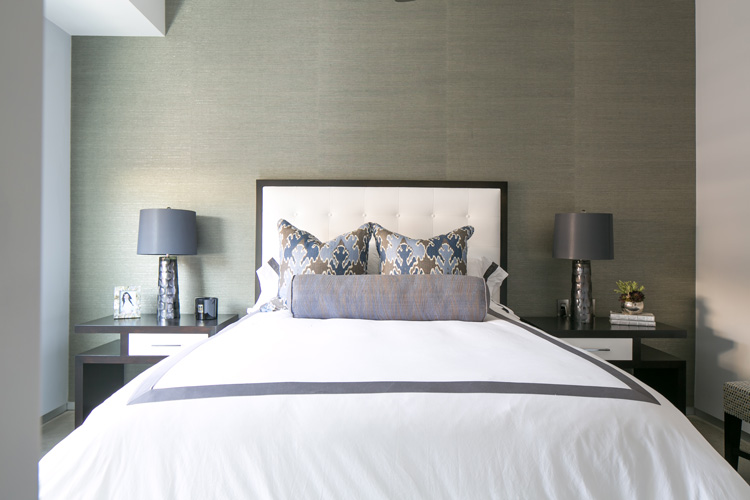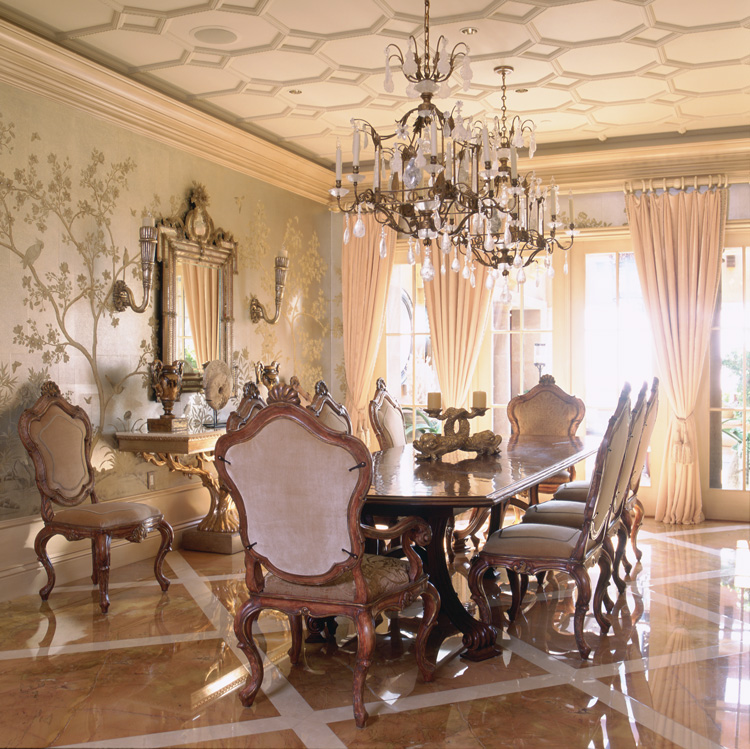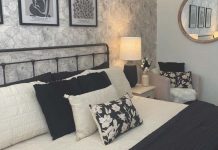By Margie Monin Dombrowski
The world of wallcoverings is opening up, one roll at a time. From wallpaper patterns that bring new life to classic decor to innovative materials that lend an Old World look, there are more design choices than ever to liven up your vertical dividers.
When setting the scene in any room, look to your walls. “Wallpaper is just one more layer we use to define architectural details,” says Wendi Young of Newport Beach-based Wendi Young Design. “It adds a lot of texture and warmth that paint just cannot do.”

Wallcoverings can add a “wow” factor and play up the design theme of any space. “It can be the finishing touch on a space and take it to the next level,” says Quin Palmer Brotherton, senior designer at Bliss Home and Design in Corona del Mar. “Wallpapers have come a long way. We’re seeing lots of different styles and textures, and people are realizing there are so many better options.”
Following the trends from Newport and afar, one of the best uses of wallcoverings is to transform your interior spaces so they resemble faraway destinations. For instance, if a room’s design was inspired by a recent trip or favorite escape, decorate the walls to recreate the locale at home.
Tropical Flavor
Natural or artificial, traditional or contemporary, grasscloth wallpaper now comes in a variety of textures and styles to blend with almost any setting. Its versatility allows it to work with any theme, but the wallcovering is particularly popular among designers and homeowners looking to add an island vibe to their space.
It’s a natural fit for a room that’s inspired by the warmth and allure of the tropics. Especially in Newport—where the coastal aesthetic has been favored for many years—creating a paradisiacal look is easy with the fibrous appearance of this material.
“Textured grasscloth is always going to be popular in Newport Beach because of the coastal vibe here,” Brotherton explains. While many homes feature wood paneling and wainscoting, “grasscloth wallpaper is always a nice accent.”
As for the color, neutral and natural hues, from beige and brown to blue and sea-foam green, are traditional beachy options, while a more modern approach could involve bolder hues and graphic designs. Newer grasscloth wallpapers include those that are painted or dyed in dark or vivid colors or patterns, some of which may have metal accents incorporated into the design. To add your own spin, Erica Bryen, owner of Newport Beach-based Erica Bryen Design, suggests putting a pattern on the ceiling. “If you want to do something wild on a small scale, like a powder bath, that would be a great place to do a fun pattern.”
Regardless of the style you’re aiming for, when choosing a grasscloth as your wallcovering, keep in mind that the seams will be noticeable. “Grasscloth is a natural product … It will not look perfect, but that’s the beauty of it,” Bryen says. “When you apply it and you come to the next roll, it can easily be a different color. When the seams touch, you will definitely see a seam. When you use a manmade product, you’re going to see a lot less seams.”
Creating a Caribbean theme, according to Young, also involves furniture selection. For an authentic and sophisticated touch, she recommends British Colonial furnishings. “[Opt for] the kind that you might find in luxury homes or hotels on the islands of St. Barts or Nevis: dark wood turned-leg furniture, Chippendale furnishings, decorative objects or patterns with palm fronds, or large palm fronds set in a vase.”

City Chic
Warm and inviting, raw brick walls can transform a local home into a space that feels more like a Brooklyn or Soho loft in New York City. As the vintage look continues to make its way into homes, natural brick often appeals to homeowners with a unique design sense and taste for nostalgia.
However, adding brick into your home doesn’t need to be a difficult or time-consuming task. Today you can create your own exposed-brick-wall effect using a wallpaper, faux brick created from stucco or drywall mud, or sheets of brick veneer that can be painted in the color of your choice.
Approach the design with care, Young advises. “If you were to use a faux brick wallcovering, depending on what you put on the wall, it could easily look cliche. It needs to be accessorized with urban loft kinds of accessories—objects with a metal finish or industrial shape or style. I’d also use industrial-style light fixtures or lamps … and maybe a textured or a shag rug.”
To make your city loft feel more at home in Newport, fill it with decor details that strike the right balance between cozy and industrial. Because brick has a tough appearance, juxtaposing it with other textures will make it more interesting. “You want it to be a mixture of surfaces,” Brotherton says. “Balance it with a clean neutral palette or soften it up with lighting, rugs, drapes and upholstery. Add in other elements for contrast, such as iron accents, nightstands or side tables. Any iron elements will play into that style.”
Other timeworn pieces and textures will work well in the space and enhance the urban aesthetic. “Bring in an old worn Ralph Lauren-looking leather sofa, a metal or zinc cocktail table, zinc or distressed metals, and a big vintage Persian rug to create that worn, lofty feel that’s popular right now,” Bryen says.
The New Rustic
The organic appeal and rugged texture of wood walls adds warmth and character to any space, whether you’re going for a modern cabin-in-the-woods or beach cottage look. Used as a feature wall or to hide imperfections, wood paneling is an on-trend idea for dressing up your walls with a soft contemporary feel.
“Wood paneling is a way to introduce interesting architecture to the interior of your home,” explains Young, who works on the architectural detailing of many Newport custom homes. The style of paneling could vary from tongue-and-groove to raised, as a whole wall or a partial wall feature. “In almost every style of home, even contemporary, we use wood paneling. Wood paneling works in any style of home.”
Veneer paneling for walls offers a sleek and rich look for contemporary homes. In a recent Crystal Cove project, Young’s design team used it throughout the home. “It doesn’t look too heavy or ornate,” she says, adding that it coordinated perfectly with a custom fireplace made of a basalt stone that resembles concrete and wood floors. In the wood veneer-paneled library, a contemporary wood desk with bronze legs, coupled with a classic Eames chair, makes an exciting contrast. “Sometimes the wood is beautiful enough it doesn’t require decoration,” says Young, who recommends adding an oversized abstract painting or something sculptural if you want to create a focal point.
Reclaimed wood accent walls are appearing in Newport homes as features in bedrooms or bathrooms, as well as reclaimed wood furnishings and ceiling details, Brotherton adds. “Some clients are more classic and coastal, and others are more edgy and want things that have more pop. A lot of clients gravitate to rustic elements that can add that texture and interest.”
Because reclaimed wood brings so much visual texture to a room, the key is to balance it with smooth textures and clean lines in your furnishings, fabrics and accessories. A neutral palette can also help tone things down to make the feature wall the focus of the room. “It’s a matter of picking and choosing what your focal points are in the space. You can’t have everything be the focus, so you have to mix in neutral pieces [to complement] the feature wall,” Brotherton advises.
Garden Variety
Wallpapers with geometric patterns—trellis and latticework in particular—are a trend inspired by the charming style of Southern homes. Some patterns are more botanical, while others may be a modern twist on a classic design, and they can feel right at home in a traditional, transitional or even a contemporary setting.
From pagodas and bamboo to hexagons, a trellis pattern can instantly make you feel like you’re in a lush garden. For a floral-inspired theme, select hues from nature, such as green or yellow, and contrasting colors and accents, such as white and gold.
“Mix in neutral colors by pulling colors from the wallpaper design out into the rest of the space, whether it’s decorative pillows or details on upholstery or accessories,” says Brotherton, whose go-to decor would include gold metallic accents, ceramic lamps, a simple jute or sisal rug, a gold metal antique side table, “almost white” upholstery and white lacquered furniture. “The style is very crisp and clean with high-contrast colors. Everything is really fresh and light with pops of color.”
Be mindful of the scale of the pattern and how it would make a room feel. The right oversized scale can be fun and inviting; an improperly scaled pattern can be off-putting. “A small pattern in a large room will feel disproportionate and a little cold, but a large scale pattern isn’t always inappropriate for a small room,” Young says. “Rules are meant to be broken.”
When your walls are covered in a lattice-style wallpaper, your other wall decor needs to stand out. Some quintessential Southern accessories, Young shares, can include wall-hung potted plants, a series of mirrors, or framed pastoral or botanical prints that will fit in with the romantic garden theme.
Whichever wallpaper pattern you choose, “make sure it’s something you absolutely love because you’re going to see it every day,” Bryen says, explaining that if you’re hesitant because you think a wallpaper pattern might be overpowering, try it on just one wall. “Maybe do the wall behind your bed—you can still create a great look. You don’t have to overdo it.”




